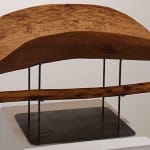Collaborative: Dianne Golding + Nancy Carnegie
11 3/4 x 7 1/8 in
The piti or wooden bowl is a woman’s traditional carrying vessel for food and water. Together with a wana or mulga wood digging stick and a wira, a smaller version of the piti used to scoop soil or ladle water, it was used by women hunting for witchetty grubs, honey ants or small burrowing animals and their eggs. After loosening the soil with a wana it was shovelled aside from the hole with the wira and the bounty carried home in the piti. (Nowadays a crow bar, a short handled shovel and a billy can are the women’s hunting tools). The piti was also used for carrying an immense variety of other desert seeds and fruits. A manguri or head-ring, was used to cushion the bowl as the women carried it on their heads to collect food and water. It is made of spun hair and emu feathers or coiled grasses.
As most contemporary Maruku artists use walka, patterns burnt into the wood with wire heated on a wood fire to relate Tjukurpa, stories about the Tjukuritja or Creation Ancestors and the activities which shaped the land, the people and their Law, this bowl is an increasingly rare example of women’s work. Dianne has also used kiti, a bush glue made from spinifex
resin, to reinforce her bowl.
Nancy Carnewgie says of her Digging Stick: "Iriti tjana kanyiningi wana, punuku wanarina. Tjana tjawalpai: tjala - honey ants; maku - witchetty grubs; tinka - goanna; ngampu - goanna eggs. Minyma tjutangku tjawalpai. Wana nyangatja.'
In the past they had digging sticks made of mulga wood. They were always digging; honey ants; witchetty grubs; goanna; eggs. It's the women who always do the work. This is a digging stick. - Kunmanara Captain, senior Pitjantjatjara woman.
The wana is carved from a straight mulga sapling (Acacia aneura) then tapered and fire hardened at one end. It is used also in digging edible roots and locating root timber for carving. After the sharp point of the wana has loosened the soil, a wira or small bowl is used to scoop the earth away from the hole. Today it is often an iron crow bar which performs the traditional function of the wana in digging for food delicacies like honey ants and witchetty grubs.





